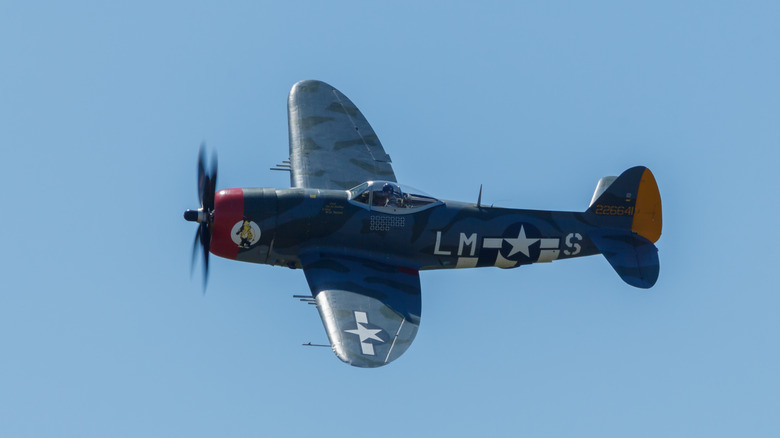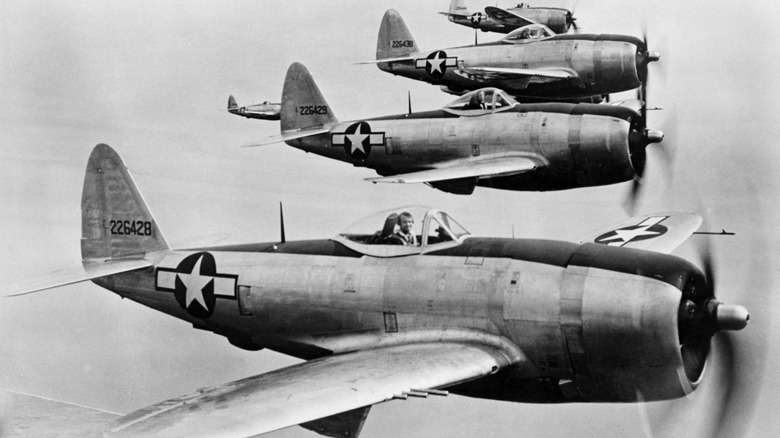Thunder In The Skies: The P-47 Thunderbolt's WW2 Legacy
Whereas the quick and agile North American P-51 Mustang, the legendary fighter that dominated the skies of World War II, and Lockheed's P-38 did indeed bring the "Lighting," Republic Aviation's P-47 Thunderbolt was precisely what its name implied. To the U.S. Army Air Forces (AAF), these three planes comprised its holy trinity of fighters.
The P-47 was powered by a 2,000 horsepower engine and armed with eight .50 caliber machine guns, so the phrase thunder in the skies was not hyperbole. It started life on a drafting board as a lightweight interceptor but evolved into the largest and heaviest single-engine fighter used by any air force during World War II.
As early reports became available in early 1940 showing that aerial combat had evolved — almost two years before the United States entered the war (in December 1941) – it was obvious that new tactics and aircraft design would be needed. Pouncing on the opportunity, Alexander Kartveli at Republic Aviation proposed a plane based around the newly built turbo-supercharged Pratt & Whitney R-2800 twin-row radial engine explicitly designed to perform better at high altitudes.
Interestingly, this concept was based on schematics for a plane Kartveli had worked on five years earlier when he was the lead designer at Seversky Aircraft Corp. (which would become Republic Aviation). His plans for the fighter known as P-35 won a competition held by the Army Air Corps that used a unique semi-elliptical wing shape, an element the P-47 would eventually feature.
The thunder rolled
What Kartveli imagined was a hulking, heavily armed fighter plane equipped with a turbo-supercharged, air-cooled radial Pratt & Whitney R-2800 engine that would give the Thunderbolt a top speed of 433 mph. However, the location of the supercharger was yet another interesting feature of the P-47.
Kartveli designed the unit to be installed near the tail and attached to hundreds of feet of ductwork (most of which was housed in the belly) that moved exhaust fumes out the rear of the plane and simultaneously returned compressed air to the engine's induction system. During testing, it was discovered that all the ductwork actually provided an extra layer of padding that helped protect pilots when they were involved in a crash.
The Thunderbolt weighed 10,000 pounds when empty. It could carry 3,400 rounds for the eight .50 caliber wing guns and 3,000 pounds of external ordnance. Astonishingly, it was able to unleash approximately half the firepower of the much larger B-17 Flying Fortress, which was one of the best American planes used in World War II When fully loaded (pilot, fuel, weapons, etc.) it tipped the scales at over 17,500 pounds.
Despite that massive weight, shortly after flying its first missions in April 1943, pilots soon realized it could out-dive nearly every enemy fighter it encountered and had a ceiling of over 42,000 feet. Between that and its ability to absorb incredible amounts of damage during combat (with a loss rate of less than one plane per mission), it earned the nickname "Juggernaut" (shortened to "Jug"), and quickly became a pilot favorite.
Dropping the power of Thor's Hammer during WWII
Between D-Day (June 1944) and VE-Day (May 1945), the P-47 earned the distinction of being the best ground-attack aircraft in the US fleet. It flew over half a million missions and dropped 132,000 tons of bombs. It destroyed over 150,000 tanks and other armored fighting vehicles, locomotives, and train cars, as well as trucks and cars. If that wasn't impressive enough, it had a 4.6-to-1 aerial kill ratio.
By the end of WWII, more than 15,600 Thunderbolts had been built (making it the most-produced US fighter) and only 3,500 were lost.
Thunderbolts flew under the British RAF, French Free Forces, and the Soviet Union in virtually every corner of the war, performing a litany of combat missions. Once Japan surrendered in September 1945, the P-47 was re-designated as the F-47.
The last US Thunderbolt was pulled from active military duty in 1949 but continued to fly for the Air National Guard until 1954. Additionally, Turkey, Portugal, and Italy (NATO countries) had active Thunderbolt squadrons into the 1950s as well, and some Latin American countries kept on flying them until the '60s. Peru didn't retire its Jugs until 1966.

